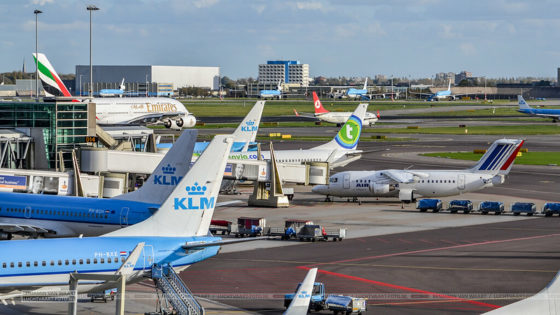Confusion about social distancing on planes: how safe is air travel?


MPs have called for clarity about social distancing rules on planes, now it has become apparent most airlines do not see the need to keep seats free in between passengers.
On trams, trains and buses, passengers are required to keep their distance and wear a face mask, but on planes, while masks are compulsory, no measures to ensure 1.5 metres distance are being taken.
A spokesman for Jaap van Dissel, head of the infectious diseases department at public health institute RIVM, told the NRC on Monday that the agency has not yet developed a standpoint with regard to flying.
However, on Sunday, Van Dissel gave an interview to broadcaster NOS in which he said the chance of becoming infected with coronavirus on a plane is ‘extremely small’.
While the situation in a bus or tram is similar to that of a plane, air circulation is different, he said. ‘In general the air is piped in from above, which can be beneficial in that droplets fall to the ground immediately,’ Van Dissel is quoted as saying.
Protocols
MPs from ruling party D66 and the opposition GroenLinks have now asked health minister Hugo de Jonge to give his opinion on the protocols drawn up by airlines on the basis of European recommendations. The RIVM, according to the NRC, is due to give its verdict this week.
Neither protocol, one drawn up by the UN aviation arm ICAO and one by European air travel lobby group EASA, are binding and there are no sanctions for airlines which do not comply.
Airlines claim that social distancing is not necessary in a plane because of all the hygiene measures they take, the fact that passengers wear masks and permanent air renewal.
Pressure
However, the NRC points out that on April 14, the Management Outbreak Team report included the sentence ‘there is pressure in the Netherlands and Europe to resume air travel’ in its report but that no-one is able to say where that pressure came from.
In addition, Van Dissel also made an oblique reference to airlines needing to keep costs down in his interview with the NOS at the weekend.
This, he said later, was not a call to give weight to economic arguments but a reaction to the economic arguments used by the aviation sector. ‘But airlines have to take care of the safety of their passengers,’ he said. ‘That is paramount.’
According to the Volkskrant, the cabinet will have to give its decision on air travel by June 15, when many European countries will open up to tourism again.
Zero risk
Louis Kroes, head of medical microbiology at Leiden teaching hospital, told RTL Nieuws that it all depends on how far people are prepared to go to try to ensure zero risk of infection.
‘Each situation has to be looked at separately,’ he said. ‘You cannot realise zero risk, but that is not always necessary.’
Around one in 10,000 people in the Netherlands are thought to be infectious with coronavirus at the current time, he said. ‘Much is known about how air circulates in planes and there is an enormous amount of ventilation,’ he said. ‘I would say that the situation on board would be manageable.’
Thank you for donating to DutchNews.nl.
We could not provide the Dutch News service, and keep it free of charge, without the generous support of our readers. Your donations allow us to report on issues you tell us matter, and provide you with a summary of the most important Dutch news each day.
Make a donation